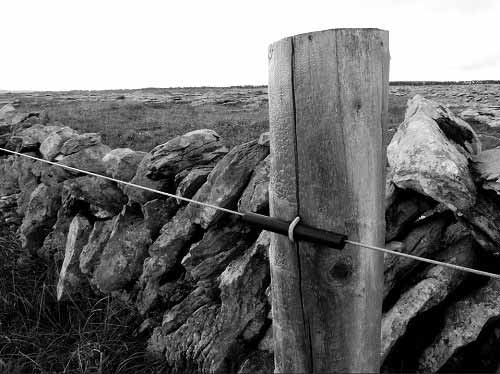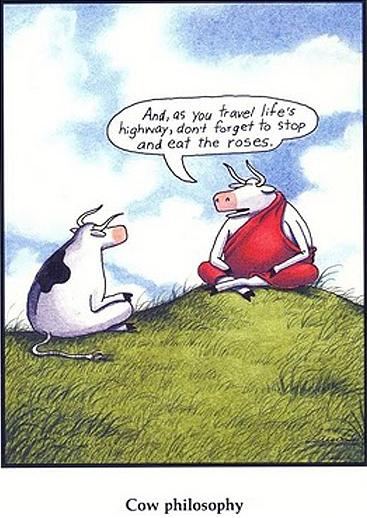Livestock Fencing Psychology:
Training Cattle to Electric Fences

Image Credit: Chad K
In this livestock fencing article I am going to explain the psychology behind the electric cattle fence and teach you how to train your cattle to respect your electric fences.
All fencing can be divided into two types: physical barriers and psychological barriers.
Physical barriers work to create physical obstructions to block cattle movement, such as by using barb wire fencing, rail fences, board fences, or page wire fences.
Psychological livestock fencing, like electric fences, work because cattle are easily trained to fear getting 'zapped' by an angry little wire, which makes them voluntarily resist pressuring the cattle fence. Simple cow psychology, rather than a physical obstruction, does the work of creating a barrier.
When switching to using electric fencing for your cattle handling needs you will need to unlearn many of your fence construction preconceptions. Physical barriers depend on the robustness of the cattle fence, whose strength must be directly proportionate to the physical pressure that your cattle are likely to put on it. But electric fencing is about training cattle and subsequently manipulating cow psychology so that the psychological fear of getting a harmless 'zap' turns a simple little smooth wire that is utterly useless as a physical barrier into an insurmountable psychological barrier that is as impenetrable as a 10 ft concrete wall. Electric fences depend not on how strong you build the cattle fence, but rather on whether you understand how to manipulate the cow psychology of the herd that you want to contain.
Physical vs. psychological cattle barriers
The polar bear and the psychological fence
Many years ago I heard a story about a captured wild polar bear that spent it's life in a cage. As the polar bear was nearing old age, his keepers decided to grant him his freedom. The cage was removed. But the polar bear didn't leave the cage. Instead, he continued to faithfully pace the perimeter of the non-existent cage.
Electric fences are like the polar bear's cage after the cage has been removed. They are a psychological barrier that cattle respect simply through psychological conditioning, not because they represent a physical barrier.
Psychological barriers are habits - habitual trained responses to a certain stimuli. In the case of electric fences, the single, thin, biting string or wire becomes a formidable psychological barrier simply because you train your cattle to respect it.
To an untrained cow, a single electric wire is about as intimidating and effective as a wet spaghetti noodle, as many of you may know from experiences with untrained cattle that break through electric fencing as though it didn't exist. Yet, once cattle are trained to electric fences, they become like the iron bars of a polar bear's cage, often far more impenetrable than even the most well-built barbed-wire cattle fence, which cattle always seem to find a way of leaning through.
Physical barriers, like barb wire livestock fencing, rail cattle fencing, or page-wire fences, actually need to physically obstruct cattle movement through the fence. The more pressure there is on this kind of cattle fence, the more wires and the stronger the fence needs to be. Range fences need at least 3 barbed wires to function effectively. Most pasture fences need 4 to 5 wires, all barbed wire for added 'bite', just to force your cattle to respect them. And these wires need to be strung as tightly as possible so the cattle can't stretch through. That's a lot of wire and a lot of posts (barb-wire fence posts need to be tightly spaced so cattle can't wriggle between the wires). They are extremely labor intensive to build. Once built, they need to be preserved for many years to pay for all the building costs. And they require a lot of maintenance to tighten wires and replace staples that are torn from posts as cattle test the wires. Moving these cattle fences to address temporary management needs is simply not feasible. Just cleaning up an old fence that needs to be rebuilt is a formidable job unto itself, which is why many barb wire fences are simply left to rot, where they become hazards to unsuspecting cattle, people, or wildlife, while new livestock fencing is simply built alongside.
 Barb wire livestock fencing is expensive to build and maintain, has a short lifespan, does not offer any flexibility, and must function as a physical barrier to restrain cattle movement.
Barb wire livestock fencing is expensive to build and maintain, has a short lifespan, does not offer any flexibility, and must function as a physical barrier to restrain cattle movement.Electric fences are psychological barriers that exist primarily in the minds of your cattle. Cattle learn to fear crossing the wire. Interior fences can be as simple as a single wire or polytape hung loosely approximately 32 to 36 inches from the ground on posts spaced 60 to 100 feet apart. Braces are simple and quick to construct because they really don't have a lot of strain on them. These cattle fences are extremely cheap and quick to build. What makes them work is the psychological fear that your cattle have of getting 'zapped'.
Getting zapped by an electric cattle fence is completely harmless. It hurts for a brief moment; neither you nor your cattle will forget the experience anytime soon. But there's no actual damage from a single zap, just a lasting impression not to cross those angry little wires again [however, it's not recommended for young children or seniors (especially with pace-makers) to touch electric livestock fencing].
Once cattle are trained to electric fencing, they will respect even the most meager wires. Notice how the cattle in this image respect the barely-visible temporary single-wire electric fence that divides their daily pasture moves.
The electric fence grid that I will show you how to construct in the electric fence installation articles only costs a fraction of what it takes to build barbed wire cattle fencing or any other kind of livestock fencing. It's extremely quick and easy to put up and if you don't like the location, it takes very little to move it or take it down.
Combining permanent and portable wires gives you the flexibility to set up temporary livestock fencing for temporary management situations. And this combination of permanent and portable wires actually means that you need very little cattle fencing on your farm, despite having sufficient control to create new pasture slices every single day of your pasture rotation. Imagine trying to build sufficient paddocks for daily pasture moves using barbed wire fencing!
Electric fences require far less maintenance than other types of livestock fencing because the cattle don't physically test the wires. Your primary damage comes from wildlife running into the cattle fence during the winter when wires are harder to spot or from trees falling on the fence. Even then, fixing a damaged electric cattle fence will only take a fraction of the time it takes to fix damaged barbwire fences. Even in reasonably dry climates barbed wire fences rarely, if ever, last longer than 25 years because the wire becomes brittle and the posts rot and no longer resist cattle pressure on the fence. Even by the time they reach the middle of their expected lifespan they will be quite worn, floppy, and high-maintenance. Electric fences, on the other hand, will typically last up to 40 years - as long as takes your fence posts to rot and fall over on their own - simply because these psychological cattle fences don't experience the physical pressure of cattle testing the wires.
Never mix barb wire fencing and electric fencing. And never electrify a barbed wire!
Barb wires cause horrid, even fatal, wounds when cattle, wildlife, or people get hung up in a barb wire fence. Extricating yourself after getting tangled in barb wire livestock fencing is difficult enough when you're calm. But if you, your cattle, or wildlife get zapped by an electric fence while tangled in barbed wire, you can just about guarantee that you, your cattle, or wildlife will be torn to shreds as you panic. A single zap from an electric wire is harmless and the smooth wire ensures that you can easily pull away to safety. But getting entangled in a barb wire fence that has been mixed with electric wires will prevent escape from repeated zapping, which may lead to electric burns that can even be fatal, although you'll likely tear yourself to shreds on the barb wires first.
Never mix barbed wires with electric fencing!
Building fences using cow psychology
(Disclosure: I get commissions for purchases made using Amazon links in my post.)
Since electric livestock fencing uses cow psychology to function effectively, it's
important to construct them according to how cattle think and how they
perceive their visual environment. Always think traffic flow.
Cattle
are herd animals. Corners in alleys that turn more than 90 degrees will
cause cattle to stall simply because those at the rear will reverse
direction to follow the movement of their leaders before they too have
cleared the corner.
Gates are always best placed in corners for
the same reason. If a gate is part way along a fence-line, some cattle
will inevitably miss the gate as they try to follow the herd leaders
before they too have rounded the gate. Place gates in locations that
make it easy to see if gates are open or closed - a cow, with monocular
vision, will find single wire fences much harder to see. An open gate
against the backdrop of another cattle fence may be impossible to
distinguish from a closed gate.

from Gary Larson's popular The Far Side cartoons. (View on Amazon.com#CommissionsEarned)
Alleys need to be wide enough to allow cattle to bunch up and therefore need to be sized to the herd sizes that you will manage in your pasture rotation. An electric fence puts a great deal of psychological pressure on your cattle if they get too close to the livestock fencing. If alleys are too narrow, the cattle will begin to panic if any traffic congestion pushes cattle up against the electric fencing. They will burst through or jump over the electric fence rather than risk getting pressed against the angry little wires.
When your cattle don't respect your electric fencing, it's not because the cattle are awful, mean, or dumb, nor is it a reflection on your electric fence effectiveness. It's simply that either the electric fence design or construction contains a flaw, which fails to have the desired psychological effect on your cattle. Perhaps the livestock fencing layout doesn't fit with cow psychology and herd traffic flow. Perhaps you haven't take the time to train your cattle to electric fencing. Usually a very simple fix will solve the problem.
The "Electric Fencing and Rotational Grazing" chapter of my book, Grass-fed Cattle: how to produce and market natual beef, provides detailed electric fence construction tips to design livestock fencing that works well with cattle psychology. This chapter also provides a wide range of cattle handling techniques when working with cattle, both in and outside of the corral.
Training cattle to electric fences
An untrained cow that has never had exposure to an electric fence has no idea that she's supposed to fear the wire. Turning untrained cattle loose in a paddock surrounded by electric fencing won't work. Your cattle will flatten your electric fences. You need to train them first.
Training cattle to electric fences is extremely easy - you simply have to create a situation that causes all of your cattle to experience a good 'zap'. Cattle born onto a farm with electric fences will simply grow up with respect for electric fencing and don't need to be trained. However, when introducing a herd to electric fences for the first time or when bringing untrained cattle onto your farm you need to artificially create a situation that introduces them to electric fences while they are still inside a pen surrounded by a physical barrier to restrain them during the training process.
My favorite way of training cattle to electric fencing is to build a single-wire cross-fence part way through your corral or some other secure small pen. Leave a wide gap on one end of the training cross-fence so cattle can roam freely between the two sides of the training fence. Put some feed on one side and provide livestock drinking water on the other side so the cattle have to make the trip around the cross-fence. With just a single wire in the middle of their pen, inevitably each of them will either nose up against the wire out of curiosity or out of sheer laziness as they attempt to take the shortcut between feed and water instead of going around. You can even put something on the wire to attract their curiosity, like a bit of peanut butter or some flag tape to attract their attention. It usually only takes a day or two for everyone in the herd to get the idea, after which they are ready to go out on pasture.
Once trained to respect electric wires, cattle become quite adept at spotting them. They will even graze directly underneath single wire fences, keeping them free of grass build-up without ever touching the cattle fence.
Tricking cattle with dummy fences
Once trained, it becomes easy to trick your cattle with temporary dummy wires when you either don't have power or can't be bothered to hook up power just for a momentary cattle handling situation that requires a little extra persuasion. Even broken energizers or under-powered fences in the winter can go unnoticed and untested by your cattle herd for many months simply because of the psychological response that you have trained in your cattle when confronted by electric fences.
For example, a single piece of highly-visible rope can easily contain an entire cattle herd milling at an unfamiliar gate, allowing a single person with the rope to quietly restrain an entire herd of cattle while they figure out the gate. This dummy wire allows you to keep the entire herd calm so they can think their way through the gate. Dummy wires put far more effective pressure on a cattle herd than a whole army of well-intentioned volunteers shouting and waving sticks.
There are endless situations where this dummy rope or dummy wire comes in handy once your cattle are trained to electric fences, from creating temporary highway crossings, to creating a temporary gate in an alley, or propping up a fake section of livestock fencing somewhere in your pasture in order to make your cattle handling easier. Once your cattle are trained to electric fences, you'll be amazed at how often a simple length of rope can trick cattle to calmly and quickly do what you want in situations that would be tremendous challenges to more traditional cattle herding tools like cattle prods, ATV's, men on horseback, and lots of rodeo-inspired shouting.
You can learn more about cow psychology, training cattle to electric fences, and low-stress cattle handling techniques in the "Managing Your Herd" chapter of my book, Grass-Fed Cattle: how to produce and market natural beef, which includes an entire section on how to work flight zones both out on pasture and inside a corral, how to construct livestock fencing and corrals that work according to how cattle perceive the audio-visual world around them, and how to train cattle to follow you during pasture moves.
Related Articles:
(Disclosure: I get commissions for purchases made using Amazon links in my post.) And when you're ready to start planning your cattle farm, check out my book: Grass-Fed Cattle: How to Produce and Market Natural Beef. Use the links below to explore my book and read reviews on Amazon: 
|




